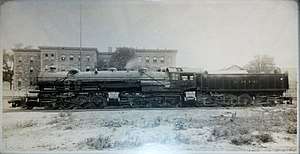Triplex (locomotive)
A Triplex locomotive is a steam locomotive that divides the driving force on its wheels by using three pairs of cylinders rigidly mounted to a single locomotive frame. Inevitably any such locomotive will be articulated. All the examples that have been produced have been of the Mallet type but with one extra set of driving wheels under the tender.


Triplex classes
Baldwin built the only three examples of the type for the Erie Railroad between 1914 and 1916.[1] The first was named Matt H. Shay, after a beloved employee of that road.[1] It could pull 650 freight cars.[2] The Erie Railroad scrapped their Triplexes from 1929, 1931, and 1933.[3] One 2-8-8-8-4 was also built, for the Virginian Railway, as No. 700, in 1916. This was class XA, so named due to the experimental nature of the locomotive. The 2-8-8-8-4 was unsuccessful because it only made a maximum speed of 3–5 miles per hour and had high maintenance costs. The XA was sent back to Baldwin Locomotive Works in 1920 to be converted to a 2-8-8-0 and a 2-8-2. These two engines were in service until 1953. Neither of the two engines were preserved.
There was also a proposal for a quadruplex super Garratt locomotive with a 2-6-6-2+2-6-6-2 wheel arrangement for South African Railways, but this was never built.[4]
Usage
The purpose of the Triplexes was banking[3] heavy trains over steep inclines, requiring high tractive effort, but low speed, over short distances.
The center set of cylinders received high-pressure steam. The exhaust from these was fed to the two other sets of cylinders, which were valved for low pressure.[3] The right cylinder exhausted into the front set of low pressure cylinders, and the left into the rear set; this is also why the high pressure cylinders have the same diameter as the low pressure ones, whereas most mallet locomotives have much smaller high pressure cylinders. The front set exhausted through the smokebox and the rear set exhausted first through a feedwater heater in the tender and then to the open air through a large pipe, which can be seen in the photo. Since only half of the exhaust steam exited through the smokebox, firebox draft (and thus boiler heating) was poor. Although the boiler was large (in line with contemporary two-cylinder and four-cylinder practice), six large cylinders demanded more steam than even such a boiler could supply.[3]
With all six cylinders operating at their full pressure (which could not be sustained for very long), the Triplexes produced huge amounts of tractive effort (TE) that may have been the highest of any steam locomotives before or since. (Westing[3] gives a figure of 160,000 lbf [710 kN] in compound mode and seems to indicate that it was the largest TE for any locomotive up to the time [1914–1916].) The Triplexes could also be considered the largest tank engines ever built since the tender had driving wheels as well and thus contributed to traction. The problem of variable adhesion on the tender unit was not a serious one, since pusher locomotives had frequent opportunities to take on additional fuel and water. In total, only four Triplexes came into existence and only in the United States; all of the Erie triplexes were retired by 1930; none were preserved. The Virginian XA #700 2-8-8-8-4 was unsuccessful. It was returned to Baldwin where it was rebuilt into a 2-8-8-0 and a 2-8-2. A two wheel trailing truck was added later, making it into a 2-8-8-2. These two locomotives were operated until 1953.
Expanding the concept
Quadruplex
In June 1914, George R. Henderson was granted US Patent 1,100,563 for a quadruplex 2-8-8-8-8-2 locomotive,[5] which was assigned to the Baldwin Locomotive Company. Baldwin submitted a design for a 2-8-8-8-8-2 quadruplex to the Atchison, Topeka, and Santa Fe Railway.[6][7][8]
The proposed quadruplex was essentially a cross between the cab-forward locomotives for the Southern Pacific and the Triplexes built for the Erie and Virginian, with a cab at the front for the driver and the rear cab for the fireman. It was a compound locomotive - the front boiler fed the front set of high-pressure cylinders, and their exhaust fed the next set back of low-pressure cylinders. Similarly, the rear boiler fed the rear set of high-pressure cylinders, and their exhaust fed the next set forward of low-pressure cylinders. The exhaust from both sets of low-pressure cylinders was vented to the atmosphere.[6]
Quintuplex
The Baldwin Locomotive Works submitted a design for a 2-8-8-8-8-8-2 quintuplex to the Atchison, Topeka, and Santa Fe Railway. The proposed quintuplex was essentially a cross between the cab-forward locomotives for the Southern Pacific and the Triplexes built for the Erie and Virginian, with a cab at the front for the driver and the rear cab for the fireman. Baldwin may have also developed a design for a 2-10-10-10-10-10-2 quintuplex locomotive; a drawing of this proposal appeared in Trains magazine. It was shown to be the largest and most powerful steam locomotive in the world.[9][10][11]
References
- Westing (1966), pp. 124–125.
- "A titan of the rails". The Independent. July 27, 1914. Retrieved July 24, 2012.
- Westing 1966, pp. 124–125.
- Leslie Paxton and David Bourne, Locomotive of the South African Railways, Struik, 1985, pp. 8–9.
- US patent 1100563, Henderson, George, "Locomotive", issued 1914-06-16, assigned to Baldwin Locomotive Works
- "The Quadraplexes". www.douglas-self.com. Retrieved 28 October 2018.
- Solomon, Brian, 2015. The Majesty of Big Steam. Voyageur Press. ISBN 978-0760348925
- Drury, George H. (1993). Guide to North American Steam Locomotives. Waukesha, Wisconsin: Kalmbach Publishing Company.
- Solomon, Brian, 2015. The Majesty of Big Steam. Voyageur Press. ISBN 978-0760348925
- Drury, George H. (1993). Guide to North American Steam Locomotives. Waukesha, Wisconsin: Kalmbach Publishing Company.
Bibliography
- Westing, Frederick (1966), The locomotives that Baldwin built. Containing a complete facsimile of the original "History of the Baldwin Locomotive Works, 1831-1923", Crown Publishing Group, ISBN 978-0-517-36167-2, LCCN 66025422.